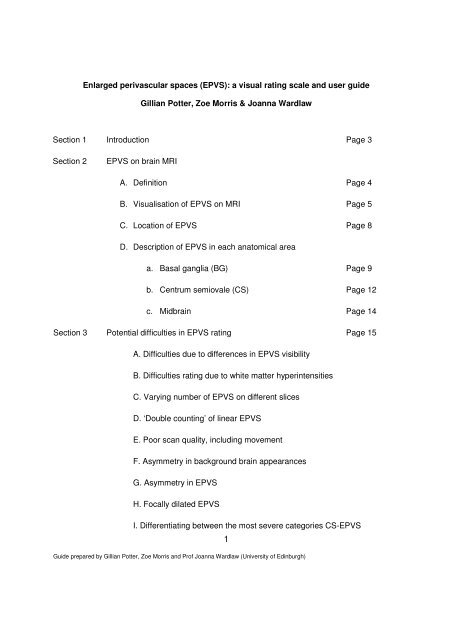Enlarged perivascular spaces (EPVS) - Brain Research Imaging ...
Enlarged perivascular spaces (EPVS) - Brain Research Imaging ...
Enlarged perivascular spaces (EPVS) - Brain Research Imaging ...
Create successful ePaper yourself
Turn your PDF publications into a flip-book with our unique Google optimized e-Paper software.
<strong>Enlarged</strong> <strong>perivascular</strong> <strong>spaces</strong> (<strong>EPVS</strong>): a visual rating scale and user guide<br />
Gillian Potter, Zoe Morris & Joanna Wardlaw<br />
Section 1 Introduction Page 3<br />
Section 2<br />
<strong>EPVS</strong> on brain MRI<br />
A. Definition Page 4<br />
B. Visualisation of <strong>EPVS</strong> on MRI Page 5<br />
C. Location of <strong>EPVS</strong> Page 8<br />
D. Description of <strong>EPVS</strong> in each anatomical area<br />
a. Basal ganglia (BG) Page 9<br />
b. Centrum semiovale (CS) Page 12<br />
c. Midbrain Page 14<br />
Section 3 Potential difficulties in <strong>EPVS</strong> rating Page 15<br />
A. Difficulties due to differences in <strong>EPVS</strong> visibility<br />
B. Difficulties rating due to white matter hyperintensities<br />
C. Varying number of <strong>EPVS</strong> on different slices<br />
D. ‘Double counting’ of linear <strong>EPVS</strong><br />
E. Poor scan quality, including movement<br />
F. Asymmetry in background brain appearances<br />
G. Asymmetry in <strong>EPVS</strong><br />
H. Focally dilated <strong>EPVS</strong><br />
I. Differentiating between the most severe categories CS-<strong>EPVS</strong><br />
1<br />
Guide prepared by Gillian Potter, Zoe Morris and Prof Joanna Wardlaw (University of Edinburgh)
J. Variations in lesion load between cohorts<br />
Section 4:<br />
The <strong>EPVS</strong> rating scale<br />
A. Rating categories & descriptions Page 26<br />
B. <strong>Imaging</strong> examples of rating categories<br />
a. Basal ganglia Page 27<br />
b. Centrum semiovale Page 34<br />
c. Midbrain Page 40<br />
References Page 41<br />
Conclusion Page 42<br />
Guide prepared by Gillian Potter, Zoe Morris and Prof Joanna Wardlaw (University of Edinburgh)<br />
2
Section 1.<br />
Introduction<br />
<strong>Enlarged</strong> <strong>perivascular</strong> <strong>spaces</strong> (<strong>EPVS</strong>, sometimes called Virchow-Robin <strong>spaces</strong>) surround the<br />
walls of vessels as they course from the subarachnoid space through the brain parenchyma. 1<br />
<strong>EPVS</strong> appear in all age groups, but are only visualised clearly on T2-weighted brain magnetic<br />
resonance imaging (MRI) when enlarged.<br />
Several <strong>EPVS</strong> rating scales have been described, 2-7 but these are either limited in their<br />
anatomical location, in the range of <strong>EPVS</strong> that they describe, or in their method of assessing<br />
severity. Additionally, some scales were tested using specific MRI sequences rather than<br />
standard structural brain MRI. We reviewed existing <strong>EPVS</strong> visual rating scales, 2-8 identified<br />
omissions or ambiguities in each, and used this combined knowledge to design improvements<br />
to one existing scale 8 that already most closely met requirements for a comprehensive easy to<br />
use scale. We then tested this revised scale on 60 MRI scans chosen to demonstrate a full<br />
range of <strong>EPVS</strong> frequencies and designed a comprehensive user guide. Using the revised scale<br />
and the user guide, two observers showed similar intra-rater agreement for BG-, CS- and<br />
midbrain <strong>EPVS</strong> ranging from good to very good kappa values. Inter-rater agreement was<br />
moderate for CS- and MB-<strong>EPVS</strong> on both ratings although very good for BG-<strong>EPVS</strong> on the initial<br />
rating. Disagreements were mainly due to the counting of very small but just visible <strong>EPVS</strong>,<br />
which were a recognised source of difficulty prior to rating. Other main causes for disagreement<br />
were the presence of background white matter hyperintensities (WMH), particularly when<br />
confluent, and lacunes (in the CS and BG regions, respectively). The user guide was<br />
subsequently modified to help avoid residual sources of observer variation.<br />
This revised <strong>EPVS</strong> rating scale includes the 3 major anatomical regions where <strong>EPVS</strong> are found:<br />
basal ganglia (BG), centrum semiovale (CS) and midbrain. 1 The development of a validated<br />
3<br />
Guide prepared by Gillian Potter, Zoe Morris and Prof Joanna Wardlaw (University of Edinburgh)
ating scale, including a user guide with illustrations, will hopefully minimise inter-observer<br />
variation in studies of <strong>EPVS</strong>, enable cross-comparison between research groups and facilitate<br />
meta-analysis of <strong>EPVS</strong> studies.<br />
Guide prepared by Gillian Potter, Zoe Morris and Prof Joanna Wardlaw (University of Edinburgh)<br />
4
Section 2.<br />
<strong>EPVS</strong> on brain MRI<br />
A. Definition<br />
<strong>EPVS</strong> may be defined on MRI as ‘small, sharply delineated structures of cerebrospinal fluid<br />
(CSF) intensity (or close to CSF intensity) measuring 3mm) and shape (spheroid; Fig<br />
1); these features are often easier to see by reviewing adjacent slices.<br />
Figure 1. Differentiating true <strong>EPVS</strong> (arrowhead) from lacunes containing CSF (thin and block<br />
arrows) in the basal ganglia using size and shape criteria<br />
© J Wardlaw, University<br />
of Edinburgh<br />
5<br />
© J Wardlaw, University<br />
of Edinburgh<br />
Guide prepared by Gillian Potter, Zoe Morris and Prof Joanna Wardlaw (University of Edinburgh)
Although often described as hypointense structures on T1 and FLAIR, many <strong>EPVS</strong> will not be<br />
visible unless severe (Fig 2).<br />
Figure 2. A. Sagittal T1 imaging showing severe <strong>EPVS</strong> in the basal ganglia (arrows). B. Axial<br />
T2 and equivalent FLAIR imaging showing a ‘spongiform’ appearance of the basal ganglia on<br />
both sides due to numerous <strong>EPVS</strong><br />
© J Wardlaw, University of Edinburgh © J Wardlaw, University of Edinburgh<br />
© J Wardlaw, University of Edinburgh © J Wardlaw, University of Edinburgh<br />
Guide prepared by Gillian Potter, Zoe Morris and Prof Joanna Wardlaw (University of Edinburgh)<br />
6
If <strong>EPVS</strong> are not identified on T2 images, it is very unlikely that they will be identified on other<br />
routine sequences. Thus, T2 images should always be reviewed first.<br />
Although others have excluded <strong>EPVS</strong> with surrounding FLAIR hyperintensity when rating <strong>EPVS</strong><br />
(Fig 3), these have been included in the current scale<br />
Figure 3. Axial FLAIR MRI showing <strong>EPVS</strong> surrounded by white matter hyperintensities (WMH)<br />
in the centrum semiovale (A, arrows) and basal ganglia (B, arrows; different patient to A). <strong>EPVS</strong><br />
without surrounding WMH are also visible in both regions (arrowheads).<br />
© J Wardlaw, University of Edinburgh<br />
Guide prepared by Gillian Potter, Zoe Morris and Prof Joanna Wardlaw (University of Edinburgh)<br />
7
© J Wardlaw, University of Edinburgh<br />
© J Wardlaw, University of Edinburgh<br />
Guide prepared by Gillian Potter, Zoe Morris and Prof Joanna Wardlaw (University of Edinburgh)<br />
8
C. Location of <strong>EPVS</strong><br />
<strong>EPVS</strong> are found throughout the brain, and are subpial <strong>spaces</strong> surrounding the perforating<br />
arteries, arterioles, veins and venules of the brain.<br />
For <strong>EPVS</strong> rating, there are three primary areas to be considered: basal ganglia, centrum<br />
semiovale and midbrain. <strong>EPVS</strong> in these areas have been kept separate in the rating scale as it<br />
is possible that they may have different underlying pathophysiology.<br />
For the basal ganglia, this will normally involve reviewing at least 3 slices, for the midbrain, 1- 2,<br />
and for the centrum semiovale, at least 3 slices.<br />
Each anatomical area will now be described in more detail.<br />
Guide prepared by Gillian Potter, Zoe Morris and Prof Joanna Wardlaw (University of Edinburgh)<br />
9
D. Description of <strong>EPVS</strong> in each anatomical area<br />
a. Basal ganglia <strong>EPVS</strong><br />
<strong>EPVS</strong> are seen in the basal ganglia along the paths of the perforating lenticulostriate arteries<br />
(arising from the middle cerebral artery), which enter the brain parenchyma inferiorly at the<br />
anterior perforated substance at the level of the anterior commissure, before coursing superiorly<br />
through the basal ganglia. However, EVPS in relation to perforating arteries in the insular cortex<br />
should be included in the basal ganglia <strong>EPVS</strong> rating.<br />
Structures to be reviewed in basal ganglia rating are shown in the following diagram:<br />
© J Wardlaw, University of Edinburgh<br />
10<br />
Guide prepared by Gillian Potter, Zoe Morris and Prof Joanna Wardlaw (University of Edinburgh)
© J Wardlaw, University of Edinburgh<br />
On standard axial T2MR imaging, <strong>EPVS</strong> in the basal ganglia most commonly appear as<br />
rounded foci of high signal (Fig 4). In the insular cortex, <strong>EPVS</strong> often appear as short linear<br />
structures due to different orientation of vessels (Fig 5).<br />
Figure 4. Basal ganglia <strong>EPVS</strong> appearing as multiple, rounded, sharply delineated foci of T2<br />
high signal (arrowheads)<br />
© J Wardlaw, University<br />
of Edinburgh<br />
11<br />
Guide prepared by Gillian Potter, Zoe Morris and Prof Joanna Wardlaw (University of Edinburgh)
© J Wardlaw,<br />
University of<br />
Edinburgh<br />
© J Wardlaw, University of Edinburgh<br />
Figure 5. Linear <strong>EPVS</strong> following the course of perforating arteries in the insular cortex (arrows)<br />
© J Wardlaw, University of Edinburgh<br />
Inferior to the basal ganglia, at the level of the anterior perforated substance (or substantia<br />
innominata) most normal people will demonstrate <strong>EPVS</strong> (Fig 6). Rating of <strong>EPVS</strong> in the basal<br />
ganglia should therefore be done above this level: <strong>EPVS</strong> at the level of the anterior commissure<br />
should be excluded from the overall rating.<br />
12<br />
Guide prepared by Gillian Potter, Zoe Morris and Prof Joanna Wardlaw (University of Edinburgh)
Figure 6. A. <strong>EPVS</strong> at the level of the anterior perforated substance (thin arrows), on the slice<br />
immediately above the upper midbrain (left image), and below the basal ganglia (circled, right<br />
image)<br />
© J Wardlaw, University of Edinburgh © J Wardlaw, University of Edinburgh © J Wardlaw, University of Edinburgh<br />
B. Magnified view showing <strong>EPVS</strong> at the level of the anterior perforated substance, where the<br />
anterior commissure is also seen (block arrow, pointing to anterior commissure (left side)<br />
© J Wardlaw, University of Edinburgh<br />
b. Centrum semiovale <strong>EPVS</strong><br />
13<br />
Guide prepared by Gillian Potter, Zoe Morris and Prof Joanna Wardlaw (University of Edinburgh)
<strong>EPVS</strong> are seen in the centrum semiovale along the paths of the perforating medullary arteries<br />
as they enter the cortical gray matter over the high convexities and extend into the white matter.<br />
On standard axial T2MR imaging, <strong>EPVS</strong> in the centrum semiovale may have 3 different<br />
appearances depending on location scan orientation and perforator vessel orientation (Fig 7).<br />
Figure 7. Varied configuration of <strong>EPVS</strong> in the centrum semiovale close to the vertex, with a<br />
combination of rounded (arrowheads), short linear (block arrow) and long linear (arrows)<br />
configurations<br />
© J Wardlaw, University of Edinburgh<br />
© J Wardlaw, University of Edinburgh<br />
14<br />
Guide prepared by Gillian Potter, Zoe Morris and Prof Joanna Wardlaw (University of Edinburgh)
More inferiorly in the centrum semiovale, <strong>EPVS</strong> are frequently seen as linear, rather than<br />
rounded structures (Fig 8). Some scales separate <strong>EPVS</strong> in the centrum semiovale into<br />
round/oval and linear (Rouhl, 2008); in this scale, only 1 rating is given to <strong>EPVS</strong> in the centrum<br />
semiovale.<br />
Figure 8. <strong>EPVS</strong> (arrows) visualised as linear structures in the centrum semiovale at the level of<br />
the bodies of the lateral ventricles (V)<br />
© J Wardlaw, University of Edinburgh<br />
15<br />
Guide prepared by Gillian Potter, Zoe Morris and Prof Joanna Wardlaw (University of Edinburgh)
c. Midbrain <strong>EPVS</strong><br />
At the junction of the midbrain and pons (Fig 9), <strong>EPVS</strong> may be seen in relation to perforating<br />
arteries arising from the short paramedian (perforating) branches of the basilar artery. On<br />
standard axial T2MR imaging, <strong>EPVS</strong> in the midbrain normally appear as rounded foci of high<br />
signal. Normally, at least 2 slices should be reviewed when assessing midbrain <strong>EPVS</strong>.<br />
Figure 9. A. Level of pons. B. Midbrain (at pons-midbrain junction), the third major site at which<br />
<strong>EPVS</strong> are seen. C. Slice above pons. A magnified view of the midbrain is also shown,<br />
demonstrating lower midbrain <strong>EPVS</strong> (arrowheads)<br />
16<br />
Guide prepared by Gillian Potter, Zoe Morris and Prof Joanna Wardlaw (University of Edinburgh)
© J Wardlaw, University of Edinburgh<br />
17<br />
Guide prepared by Gillian Potter, Zoe Morris and Prof Joanna Wardlaw (University of Edinburgh)
Section 3.<br />
Potential difficulties in <strong>EPVS</strong> rating<br />
A. Variations in <strong>EPVS</strong> visibility<br />
With current MRI scanners, some <strong>EPVS</strong> may be seen as faint, indistinct high signal structures in<br />
the basal ganglia, centrum semiovale and midbrain rather than clear, very high – near-CSF<br />
signal – structures (Fig 10, 11). A general impression of the region being rated should be used<br />
to choose a category, using the ‘whole picture’ and matching as closely as possible with the<br />
categories provided.<br />
Figure 10. Multiple tiny <strong>EPVS</strong> visualised in the centrum semiovale, in a patient with additional<br />
movement artefact.<br />
© J Wardlaw, University of Edinburgh © J Wardlaw, University of Edinburgh<br />
18<br />
Guide prepared by Gillian Potter, Zoe Morris and Prof Joanna Wardlaw (University of Edinburgh)
Figure 11. Multiple tiny <strong>EPVS</strong> visualised in the basal ganglia, where other <strong>EPVS</strong> are also seen<br />
far more clearly.<br />
© J Wardlaw, University of Edinburgh<br />
19<br />
Guide prepared by Gillian Potter, Zoe Morris and Prof Joanna Wardlaw (University of Edinburgh)
B. Background WMH<br />
Where there are extensive WMHs, <strong>EPVS</strong> may be difficult to rate. In such cases, an estimate<br />
must be made of the closest rating category, using the appearance of non-involved white matter<br />
(where visible), and cortical gray matter. Review of all slices, including those at the vertex may<br />
be useful, where uninvolved white matter, and cortical gray matter, may be more easily visible<br />
(Fig 12). Some <strong>EPVS</strong> may also remain visible despite the presence of extensive WMH. Where<br />
WMH are non-confluent, rating may be more straightforward (Fig 13); in such cases, nonaffected<br />
parenchyma should be used, and review of gray matter may also help.<br />
20<br />
Guide prepared by Gillian Potter, Zoe Morris and Prof Joanna Wardlaw (University of Edinburgh)
Figure 12. Extensive deep WMHs in the centrum semiovale, extending to the vertex.<br />
Appearances closer to the vertex (magnified image, bottom right image) suggest only mild<br />
<strong>EPVS</strong><br />
© J Wardlaw, University of Edinburgh<br />
© J Wardlaw, University of Edinburgh © J Wardlaw, University of Edinburgh<br />
© J Wardlaw, University of Edinburgh<br />
© J Wardlaw, University of Edinburgh<br />
21<br />
Guide prepared by Gillian Potter, Zoe Morris and Prof Joanna Wardlaw (University of Edinburgh)
Figure 13.Non-confluent WMHs<br />
© J Wardlaw, University<br />
of Edinburgh<br />
© J Wardlaw, University<br />
of Edinburgh<br />
© J Wardlaw, University<br />
of Edinburgh<br />
22<br />
Guide prepared by Gillian Potter, Zoe Morris and Prof Joanna Wardlaw (University of Edinburgh)
C. Varying number of <strong>EPVS</strong> on different slices<br />
The number of <strong>EPVS</strong> may vary depending on the slice selected. For example, in some patients,<br />
fewer <strong>EPVS</strong> will be visualised in the centrum semiovale at the level of the vertex compared to<br />
slices below this (Fig 14). After reviewing all relevant slices for the anatomical area being<br />
assessed, the highest number of <strong>EPVS</strong> should be recorded.<br />
Figure 14. Axial T2-weighted images slices demonstrating varying numbers of <strong>EPVS</strong> at<br />
different levels of centrum semiovale, with fewer <strong>EPVS</strong> visible closer to the vertex (right image)<br />
© J Wardlaw, University<br />
of Edinburgh<br />
© J Wardlaw, University<br />
of Edinburgh<br />
23<br />
Guide prepared by Gillian Potter, Zoe Morris and Prof Joanna Wardlaw (University of Edinburgh)
D. ‘Double counting’ of linear <strong>EPVS</strong><br />
Care should be taken to try to avoid counting linear <strong>EPVS</strong> twice, particularly in the centrum<br />
semiovale (Fig 15). Review of slices closer to the vertex – where <strong>EPVS</strong> are more often<br />
punctuate, rather than linear – may help in form an initial impression of the closest rating<br />
category. In all areas, review of adjacent slices can help reduce this potential problem.<br />
Figure 15. Illustration of potential pitfall of double counting <strong>EPVS</strong> in the centrum semiovale<br />
© J Wardlaw, University<br />
of Edinburgh<br />
24<br />
Guide prepared by Gillian Potter, Zoe Morris and Prof Joanna Wardlaw (University of Edinburgh)
E. Poor scan quality, including movement<br />
In some cases, <strong>EPVS</strong> rating may be made more difficult due to limited scan quality, particularly<br />
in patients with mild/moderate <strong>EPVS</strong> (Fig 16A) rather than frequent/ severe <strong>EPVS</strong> (Fig 16B). In<br />
such cases, an estimate of the closing rating category should be made.<br />
Figure 16. Limited MRI scan quality due to movement, making assessment of small structures<br />
more difficult, particularly where <strong>EPVS</strong> are mild (A) rather than frequent (B)<br />
© J Wardlaw, University of Edinburgh © J Wardlaw, University of Edinburgh<br />
25<br />
Guide prepared by Gillian Potter, Zoe Morris and Prof Joanna Wardlaw (University of Edinburgh)
F. Asymmetry in background brain appearances<br />
When background brain parenchyma is asymmetric due to the presence of another lesion, e.g.<br />
infarction (Fig 17A), <strong>EPVS</strong> should be rated on the other side where possible, or an estimate<br />
made of the closest category. Lacunes (fully, partially or non-cavitated) in the basal ganglia may<br />
also lead to difficulties in rating (Fig 17B); again, an estimate must be made of the closest<br />
category.<br />
Figure 17. A. Asymmetry of background brain parenchyma due to an infarct in the right parietooccipital<br />
lobe on T2-weighted MRI (arrow). B. Fully cavitated (short arrow), partially cavitated<br />
(thick arrow) and probably non-cavitated (arrowhead) lacunar lesions in the basal ganglia on T2<br />
and FLAIR MRI. The exact nature of the lesion indicated by the long arrow is less certain - this<br />
could represent a cavitated lacune or <strong>EPVS</strong> with surrounding WMH<br />
© J Wardlaw,<br />
University of<br />
Edinburgh<br />
© J Wardlaw,<br />
University of<br />
Edinburgh<br />
© J Wardlaw,<br />
University of<br />
Edinburgh<br />
26<br />
Guide prepared by Gillian Potter, Zoe Morris and Prof Joanna Wardlaw (University of Edinburgh)
G. Asymmetry in <strong>EPVS</strong><br />
In some patients, <strong>EPVS</strong> may show significant asymmetry (Fig 18). In such cases, the side with<br />
the higher number should be counted<br />
Figure 18. Marked asymmetry in <strong>EPVS</strong>, with a higher number of <strong>EPVS</strong> in the posterior cerebral<br />
artery territory on the right side (arrows)<br />
© J Wardlaw,<br />
University of<br />
Edinburgh<br />
© J Wardlaw,<br />
University of<br />
Edinburgh<br />
© J Wardlaw,<br />
University of<br />
Edinburgh<br />
27<br />
Guide prepared by Gillian Potter, Zoe Morris and Prof Joanna Wardlaw (University of Edinburgh)
H. Focally dilated <strong>EPVS</strong><br />
In some patients, focally dilated <strong>EPVS</strong> will be seen amongst uniformly dilated <strong>EPVS</strong> (Fig 19).<br />
The rating scale does not specifically take account of these.<br />
Figure 19. Focally dilated <strong>EPVS</strong> (arrows) amongst uniformly dilated <strong>EPVS</strong><br />
© J Wardlaw,<br />
University of<br />
Edinburgh<br />
I. Differentiating between the most severe categories of centrum semiovale <strong>EPVS</strong><br />
In many patient cohorts, the number of patients exhibiting the highest numbers/most severe<br />
degrees of <strong>EPVS</strong> in the centrum semiovale will be limited. Experience in rating the highest<br />
degrees of <strong>EPVS</strong> will thus be limited for the majority of people performing <strong>EPVS</strong> rating.<br />
J. Variations in lesion load between cohorts<br />
Rating of <strong>EPVS</strong> may vary with lesion load, as found in observer reliability testing for WMH 9<br />
intermittent review of the full range of <strong>EPVS</strong> which may be encountered in patients – as<br />
demonstrated in this guide – is advised in order to help raters ‘recalibrate’. Differences in MRI<br />
28<br />
Guide prepared by Gillian Potter, Zoe Morris and Prof Joanna Wardlaw (University of Edinburgh)
parameters may also contribute to observer differences, although this is a parameter which may<br />
be difficult to alter in the majority of cases.<br />
29<br />
Guide prepared by Gillian Potter, Zoe Morris and Prof Joanna Wardlaw (University of Edinburgh)
Section 4.<br />
The <strong>EPVS</strong> scale<br />
A. Rating categories & descriptions for each anatomical area<br />
Rating<br />
Description<br />
Basal ganglia and centrum semiovale 0 No <strong>EPVS</strong><br />
1 1-10 <strong>EPVS</strong> (mild)<br />
2 11-20 <strong>EPVS</strong> (moderate)<br />
3 21-40 <strong>EPVS</strong> (frequent)<br />
4 >40 <strong>EPVS</strong> (severe)<br />
Midbrain 0 No EVPS visible<br />
1 <strong>EPVS</strong> visible<br />
Notes:<br />
Review both sides of the brain for <strong>EPVS</strong>, but use the highest number from 1 side only<br />
Review all relevant slices, but use the slice with the highest number of <strong>EPVS</strong><br />
In cases where rating is difficult (e.g. due to movement, extensive WMH or uncertainty due to<br />
variations in <strong>EPVS</strong> visibility), select the closest category<br />
In cases of marked asymmetry (rare), record the score for the side of the brain with more <strong>EPVS</strong><br />
For basal ganglia <strong>EPVS</strong>, do not include <strong>EPVS</strong> in the anterior perforated substance (see above)<br />
30<br />
Guide prepared by Gillian Potter, Zoe Morris and Prof Joanna Wardlaw (University of Edinburgh)
B. <strong>Imaging</strong> examples for rating categories<br />
a. Basal ganglia<br />
Basal ganglia<br />
1-10 <strong>EPVS</strong> – category 1 (one example)<br />
31<br />
Guide prepared by Gillian Potter, Zoe Morris and Prof Joanna Wardlaw (University of Edinburgh)
© J Wardlaw,<br />
University of<br />
Edinburgh<br />
© J Wardlaw, University of Edinburgh<br />
Basal ganglia<br />
11-20 <strong>EPVS</strong> – category 2<br />
Example 1 of 2<br />
32<br />
Guide prepared by Gillian Potter, Zoe Morris and Prof Joanna Wardlaw (University of Edinburgh)
© J Wardlaw,<br />
University of<br />
Edinburgh<br />
© J Wardlaw, University of Edinburgh<br />
Basal ganglia<br />
11-20 <strong>EPVS</strong> – category 2<br />
33<br />
Guide prepared by Gillian Potter, Zoe Morris and Prof Joanna Wardlaw (University of Edinburgh)
Example 2 of 2<br />
© J Wardlaw,<br />
University of<br />
Edinburgh<br />
© J Wardlaw, University of Edinburgh<br />
Basal ganglia<br />
34<br />
Guide prepared by Gillian Potter, Zoe Morris and Prof Joanna Wardlaw (University of Edinburgh)
20-40 <strong>EPVS</strong> – category 3<br />
Example 1 of 2<br />
© J Wardlaw,<br />
University of<br />
Edinburgh<br />
© J Wardlaw, University of Edinburgh<br />
35<br />
Guide prepared by Gillian Potter, Zoe Morris and Prof Joanna Wardlaw (University of Edinburgh)
Basal ganglia<br />
20-40 <strong>EPVS</strong> – category 3<br />
© J Wardlaw,<br />
University of<br />
Edinburgh<br />
© J Wardlaw, University of Edinburgh<br />
36<br />
Guide prepared by Gillian Potter, Zoe Morris and Prof Joanna Wardlaw (University of Edinburgh)
Basal ganglia<br />
>40 <strong>EPVS</strong> – category 4<br />
Example 1 of 2<br />
37<br />
Guide prepared by Gillian Potter, Zoe Morris and Prof Joanna Wardlaw (University of Edinburgh)
© J Wardlaw,<br />
University of<br />
Edinburgh<br />
© J Wardlaw,<br />
University of<br />
Edinburgh<br />
Basal ganglia<br />
>40 <strong>EPVS</strong> – category 4<br />
38<br />
Guide prepared by Gillian Potter, Zoe Morris and Prof Joanna Wardlaw (University of Edinburgh)
Example 2 of 2<br />
© J Wardlaw,<br />
University of<br />
Edinburgh<br />
© J Wardlaw,<br />
University of<br />
Edinburgh<br />
39<br />
Guide prepared by Gillian Potter, Zoe Morris and Prof Joanna Wardlaw (University of Edinburgh)
. Centrum semiovale<br />
Centrum semiovale<br />
1-10 <strong>EPVS</strong> – category 1<br />
© J Wardlaw,<br />
University of<br />
Edinburgh<br />
© J Wardlaw,<br />
University of<br />
Edinburgh<br />
40<br />
Guide prepared by Gillian Potter, Zoe Morris and Prof Joanna Wardlaw (University of Edinburgh)
Centrum semiovale<br />
11-20 <strong>EPVS</strong> – category 2<br />
Example 1 of 2<br />
© J Wardlaw,<br />
University of<br />
Edinburgh<br />
© J Wardlaw,<br />
University of<br />
Edinburgh<br />
41<br />
Guide prepared by Gillian Potter, Zoe Morris and Prof Joanna Wardlaw (University of Edinburgh)
Centrum semiovale<br />
11-20 <strong>EPVS</strong> – category 2<br />
Example 2 of 2<br />
© J Wardlaw,<br />
University of<br />
Edinburgh<br />
© J Wardlaw,<br />
University of<br />
Edinburgh<br />
42<br />
Guide prepared by Gillian Potter, Zoe Morris and Prof Joanna Wardlaw (University of Edinburgh)
Centrum semiovale<br />
20-40 <strong>EPVS</strong> – category 3<br />
© J Wardlaw,<br />
University of<br />
Edinburgh<br />
© J Wardlaw,<br />
University of<br />
Edinburgh<br />
43<br />
Guide prepared by Gillian Potter, Zoe Morris and Prof Joanna Wardlaw (University of Edinburgh)
Centrum semiovale<br />
>40 <strong>EPVS</strong> – category 4<br />
Example 1 of 2<br />
© J Wardlaw,<br />
University of<br />
Edinburgh<br />
© J Wardlaw,<br />
University of<br />
Edinburgh<br />
44<br />
Guide prepared by Gillian Potter, Zoe Morris and Prof Joanna Wardlaw (University of Edinburgh)
Centrum semiovale<br />
>40 <strong>EPVS</strong> – category 4<br />
Example 2 of 2<br />
© J Wardlaw,<br />
University of<br />
Edinburgh<br />
© J Wardlaw,<br />
University of<br />
Edinburgh<br />
45<br />
Guide prepared by Gillian Potter, Zoe Morris and Prof Joanna Wardlaw (University of Edinburgh)
c. Midbrain<br />
<strong>EPVS</strong> visible – category 1<br />
© J Wardlaw, University of Edinburgh<br />
46<br />
Guide prepared by Gillian Potter, Zoe Morris and Prof Joanna Wardlaw (University of Edinburgh)
References<br />
1. Kwee RM, Kwee TC. Virchow-Robin <strong>spaces</strong> at MR imaging. RadioGraphics 2007;1071-1089.<br />
2. Patankar TF, Mitra D, Varma A, Snowden J, Neary D, Jackson A. Dilatation of the Virchow-<br />
Robin space is a sensitive indicator of cerebral microvascular disease: study in elderly patients<br />
with dementia. Am J Neuroradiol 2005;26:1512-1520.<br />
3. Rouhl RPW, van Oostenbrugge RJ, Knotterus ILH, Staals JEA, Lodder J. Virchow-Robin<br />
<strong>spaces</strong> relate to cerebral small vessel disease severity. J Neurol 2008;255:692-696.<br />
4. Heier LA, Bauer CJ, Schwartz L, Zimmerman RD, Morgello S, Deck MD. Large Virchow-<br />
Robin <strong>spaces</strong>: MR-clinical correlation. Am J Neuroradiol 1989;10:929-936.<br />
5. Groeschel S, Chong WK, Surtees R, Hanefeld F. Virchow-Robin <strong>spaces</strong> on magnetic<br />
resonance images: normative data, their dilatation, and a review of the literature.<br />
Neuroradiology 2006;48:745-754.<br />
6. Di Costanza A, Di Salle F, Santoro L, Bonavita V, Tedeschi G. Dilated Virchow-Robin <strong>spaces</strong><br />
in myotonic dystrophy: frequency, extent and significance. Eur Neurol 2001;46:131-139.<br />
7. Adachi T, Kobayashi S, Yamaguchi S, Okada K. MRI findings of small subcortical “lacunarlike”<br />
infarction resulting from large vessel disease. J Neurol 2000;247:280-285.<br />
8. MacLullich AM, Wardlaw JM, Ferguson KJ, Starr JM, Seckl JR, Deary IJ. <strong>Enlarged</strong><br />
<strong>perivascular</strong> <strong>spaces</strong> are associated with cognitive function in healthy elderly men. J Neurol<br />
Neurosurg Psychiatry 2004;75:1519-1523.<br />
9. Wardlaw JM, Ferguson KJ, Graham C. White matter hyperintensities and rating scales –<br />
observer reliability varies with lesion load. J Neurol 2004;251:584-590.<br />
47<br />
Guide prepared by Gillian Potter, Zoe Morris and Prof Joanna Wardlaw (University of Edinburgh)
Conclusion<br />
Because the clinical implications of <strong>EPVS</strong> remain to be established, there is still an opportunity<br />
to improve the reliability of <strong>EPVS</strong> assessment by the use of the <strong>EPVS</strong> rating scale, so that<br />
adequately powered, well designed studies will be able to answer the outstanding clinical<br />
concerns about their diagnostic and prognostic value within the spectrum of cerebral small<br />
vessel disease, and whether <strong>EPVS</strong> should influence patient management. Although we have<br />
developed and tested a visual rating scale, automated <strong>EPVS</strong> measurement methods may be<br />
possible with improved image processing algorithms in future.<br />
48<br />
Guide prepared by Gillian Potter, Zoe Morris and Prof Joanna Wardlaw (University of Edinburgh)













